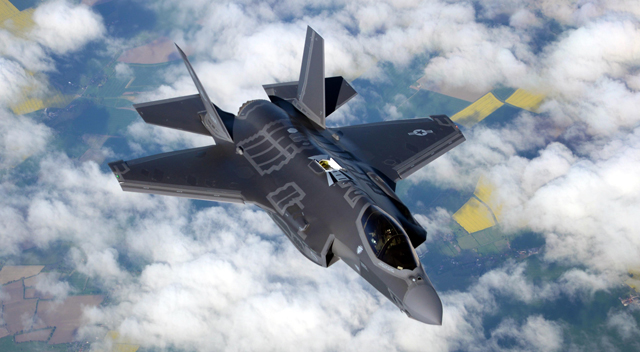The US Air Force and Missile Defense Agency (MDA) are examining integrating the Lockheed Martin F-35 Lightning II into the US ballistic missile defense system.
The stealth fighter’s abilities, especially its sensors, were highlighted as part of the Pentagon’s Missile Defense Review, released on 17 January, which stressed Russia, China, Iran and North Korea’s growing arsenal of cruise and ballistic missiles as a potential threat to US security.
“DoD’s newest tactical aircraft, the F-35 Lightning II, has a capable sensor system that can detect the infrared signature of a boosting missile and its computers can identify the threatening missile’s location. The F-35 also can transmit tracking data to the Joint Force for network centric warfighting,” says the report. “It can track and destroy adversary cruise missiles today, and, in the future, can be equipped with a new or modified interceptor capable of shooting down adversary ballistic missiles in their boost phase and could be surged rapidly to hotspots to strengthen US active defense capabilities and attack operations.”
A joint report for integrating the F-35 into the US missile defence would be issued within the next six months, says the Pentagon.

Lockheed Martin F-35 Lighning II
US Air Force
Adding the F-35 into US missile defenses is part of a larger plan to move anti-missile systems closer to threatening adversaries as potential conflict or launches arise. For example, surface-to-air missiles, such as the ground-based, Raytheon-made MIM-104 Patriot or Lockheed Martin-made Terminal High Altitude Area Defense (THAAD) systems, as well as the ship-based, Lockheed Martin-made Aegis Combat System, could be moved into position quickly in a crisis to strengthen the USA’s defense against rogue state missile threats, says the Defense Department.
The Missile Defense Review also noted the potential uses of airborne lasers as a counter ballistic missile weapon.
“Intercepting offensive missiles in their boostphase (before the re-entry vehicle separates from the booster) using kinetic interceptors and/or directed energy would increase the likelihood of successfully countering the threat,” says the report. That would “complicate an aggressor’s attack calculus by reducing its confidence in its missile attack planning, and reduce the number of midcourse or terminal active defense interceptors needed to destroy the adversary’s remaining offensive missiles.”
Using the F-35 as a platform for shooting lasers at launching ballistic missiles was not mentioned in the review, though the MDA’s Low-Power Laser Demonstrator programme was noted. In September, as part of that programme the agency awarded nearly $70 million in contracts to Lockheed Martin, Boeing and General Atomics Electromagnetic Systems to further develop airborne anti-ballistic missile lasers.
Source: FlightGlobal.com


























